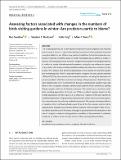Assessing factors associated with changes in the numbers of birds visiting gardens in winter : are predators partly to blame?
Date
11/2019Metadata
Show full item recordAbstract
The factors governing the recent declines observed in many songbirds have received much research interest, in particular whether increases of avian predators have had a negative effect on any of their prey species. In addition, further discussion has centered on whether or not the choice of model formulation has an effect on model inference. The study goal was to evaluate changes in the number of 10 songbird species in relation to a suite of environmental covariates, testing for any evidence in support of a predator effect using multiple model formulations to check for consistency in the results. We compare two different approaches to the analysis of long‐term garden bird monitoring data. The first approach models change in the prey species between 1970 and 2005 as a function of environmental covariates, including the abundance of an avian predator, while the second uses a change–change approach. Significant negative relationships were found between Eurasian Sparrowhawk Accipiter nisus and three of the 10 species analyzed, namely house Sparrow Passer domesticus, starling Sturnus vulgaris, and blue tit Cyanistes caeruleus. The results were consistent under both modeling approaches. It is not clear if this is a direct negative impact on the overall populations of these species or a behavioral response of the prey species to avoid feeding stations frequented by Sparrowhawks (which may in turn have population consequences, by reducing available resources). The species showing evidence of negative effects of Sparrowhawks were three of the four species most at risk to Sparrowhawk predation according to their prevalence in the predator's diet. The associations could be causal in nature, although in practical terms the reduction in the rate of change in numbers visiting gardens accredited to Sparrowhawks is relatively small, and so unlikely to be the main driver of observed population declines.
Citation
Swallow , B T , Buckland , S T , King , R & Toms , M P 2019 , ' Assessing factors associated with changes in the numbers of birds visiting gardens in winter : are predators partly to blame? ' , Ecology and Evolution , vol. 9 , no. 21 , pp. 12182-12192 . https://doi.org/10.1002/ece3.5702
Publication
Ecology and Evolution
Status
Peer reviewed
ISSN
2045-7758Type
Journal article
Description
BTS was part‐funded by EPSRC/NERC grant EP/10009171/1.Collections
Items in the St Andrews Research Repository are protected by copyright, with all rights reserved, unless otherwise indicated.

